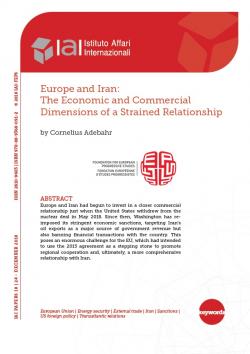Europe and Iran: The Economic and Commercial Dimensions of a Strained Relationship
Europe and Iran had begun to invest in a closer commercial relationship just when the United States withdrew from the nuclear deal in May 2018. Since then, Washington has re-imposed its stringent economic sanctions, targeting Iran’s oil exports as a major source of government revenue but also banning financial transactions with the country. This poses an enormous challenge for the EU, which had intended to use the 2015 agreement as a stepping stone to promote regional cooperation and, ultimately, a more comprehensive relationship with Iran.
Paper produced in the framework of the IAI-FEPS project entitled “Europe and Iran in a fast-changing Middle East: Confidence-building measures, security dialogue and regional cooperation”, December 2018.
-
Details
Rome, IAI, December 2018, 17 p. -
In:
-
Issue
18|24 -
ISBN/ISSN/DOI:
978-88-9368-091-2
Introduction
1. Unfulfilled expectations: EU-Iran trade after the nuclear deal
1.1 The EU’s efforts to deliver on the economic side of the deal
1.2 Always a problem: Doing business in Iran
1.3 Turning point: Washington’s withdrawal from the nuclear deal in 2018
2. “Maximum pressure” vs. “blocking regulation”: How Washington aims to squeeze Tehran – and how Brussels is responding
2.1 US sanctions have returned in full force
2.2 Europe’s efforts to shield its business will continue in the shadow of geopolitics
3. Mission impossible? The EU tries to preserve relations with Iran while strengthening European autonomy
References



